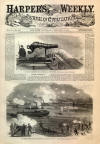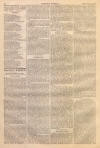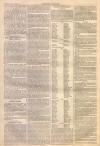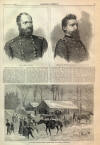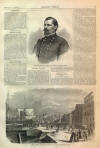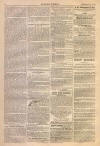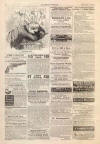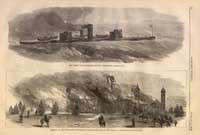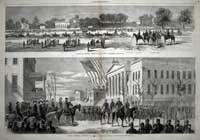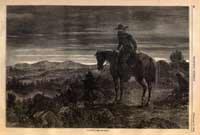General Hazen
|
|
This Site:
|
FEBRUARY 11, 1865.] HARPER'S WEEKLY. 93 THE SCOUT.WE call the attention of our readers to the sketch engraved on the preceding page. No feature connected with our military operations is so interesting or so abundant in thrilling incident as what is called the secret service. This has been especially the case in the West. For the most part the details of this service have been hidden from the public. It was necessary that it should be, both for the success of important movements and for the sake of the gallant heroes engaged in this branch of the service. This veil of secrecy has covered in temporary obscurity the most romantic incidents of the war incidents, too, upon which oftentimes the fate of battles has hung. These will some time be made known, and will form an interesting portion of the history of this war, relieving the tedious details of marches and manoeuvres. GENERAL HAZEN.WE give on this page a portrait of Brevet Major-General WILLIAM B. HAZEN, the hero of Fort McAllister. General HAZEN is a native of Vermont, from which State he was appointed to the Military Academy at West Point, where he graduated in 1855, with the brevet rank of Second Lieutenant. He entered the war in November, 1861, as Colonel of the Forty-first Ohio Regiment. This regiment was afterward attached to PALMER'S division of the Army of the Cumberland, in which General HAZEN commanded a brigade from January, 1862. This was the Nineteenth Brigade, of NELSON'S old division, and which had marched with that General to Shiloh, followed him to Corinth, and through the summer campaign in Western Tennessee, Mississippi, and Alabama, and afterward had participated in the Kentucky campaign in the fall of 1862. General HAZEN took an important part in the battle of Murfreesborough, or Stone River. on the right of ROSECRAN'S left wing. His brigade held an important position in that battle, and but for his persistent defense the partial disaster of the 31st of December would have been turned into defeat. General HAZEN commands a division of the Fifteenth Corps. FROM SAVANNAH.WE give on this page, and on pages 88 and 89, several interesting sketches from our special artists in Savannah. Soon after the Federal occupation of the city General SHERMAN gave the citizens the privilege of staying quietly at home or of taking their departure for some other point in the Confederacy. Accordingly, those who were not disposed to remain under the protecting folds of the old flag were quietly ordered to take passage on the steamer S. R. Spaulding. Captain AUDINRIED, of General SHERMAN'S staff, had charge of the flag of truce that was to take them through. General SHERMAN has instituted careful reviews of his entire army previous to its entrance upon a new campaign. General BARRY conducted the review of the artillery, which is in a splendid condition. The cavalry under KILPATRICK is pronounced fit for any service. The campaign upon which General SHERMAN has entered is of stupendous proportions, and the resistance to be overcome will probably be very great. GENERAL WAGNER.THE country has not forgotten the heroes of the Battle of Franklin, fought November 30, 1864. Prominent among these was Brigadier-General G. D. WAGNER. The line of battle, it will be remembered, was formed by General SCHOFIELD so as to cover Franklin. The Fourth Corps under STANLEY held the right, and the Twenty-third under Cox the left ; WAGNER'S brigade, of the Twenty-fourth, connected with RILEY'S of the Fourth, forming the centre. It was against this point that the rebel army under HOOD directed its most impetuous charges. Our readers remember how WAGNER and RILEY met these repeated charges, until, overborne by superior numbers, they fell back ; and how, being reinforced, they again recovered their ground, taking a large number of prisoners. General WAGNER entered the war as Colonel of the Fifteenth Indiana Volunteers, and gained great distinction in the West Virginia campaign, in the autumn of 1861. CORRESPONDENCE.LETTER FROM A SOLDIER.THE world's ear is full of cries from the shadowland of rebel barbarism, where suffering and death sit at every prison door, and starvation walks at the side of every captive. Thousands of true hearts at the North have bled at the recital of the horrors of the Libey, of Andersonville, Danville, and Salisbury ; and far lands, looking across the ocean, have shuddered as the spectacle of rebel barbarity developed before their eyes, wondering how, in a Christian land, such things could be. It is perhaps an old story now; but if you will let me, I will tell you what I have seen and felt and know of slave holders' mercy while yet the touch of their fierce cruelty is upon me. My introduction into the living death at Andersonville occurred on the 7th of July last, and I remained in its clutch until the 22d of October following. In all that period not one gleam of comfort illuminated the misery of our bondage. The camp embraced thirty acres, surrounded by a stockade twelve feet high. Here during the month of August 30,000 prisoners were crowded together like cattle, for the most part without any shelter what. ever from the heat or frequent rains. At night, during rainy weather, they lay on the ground in groups, remaining thus until morning, wet to the skin, and with no fire to dry their scanty clothing. Occasionally the days were intensely hot, followed by rainy nights, inducing necessarily sickness among all except the more robust, the want of proper food predisposing the system to disease. The daily fare consisted of less than a pint of used, four spoonfuls of rice, three spoonfuls of beans, and two ounces of bacon ; sometimes, however, only a part of these articles were received, and then in a damaged state. A favorite dish consisted in taking a pint of meal, mixing it with water, and making it into dumplings about the size of an egg, which were boiled with pieces of bacon of the size of marbles until they floated on the top of the soup thus made. Then taking out the dumplings, we cut them open and poured in the soup having thus a dish which to us was a luxury, though in other times we would not have insulted our palates by offering them such a "mess." Sometimes we made coffee by burning pieces of cornbread, and boiling it in tin cups, drinking the product, of course, without either sugar or milk. At other times, in the absence of other food, we dug up roots and ate them. There being no sanitary regulations in the camp, and no proper medical provisions, sickness and death were inevitable accompaniments of our imprisonment. Thousands of the prisoners were so afflicted with scurvy that their limbs were ready to drop from their bodies. I have seen the maggots scooped out by the handful from the sores of these sufferers. I have seen others, mere skeletons, wasted by disease, dying by inches, with not an ounce of medicine, nor a hand lifted any where among those in charge of the camp for their relief'. On one occasion, when a physician gave notice that he would examine a portion of the sick men, over three thousand poor wretches, scarcely able to crawl, appeared before him; some carried on stretchers, and others in blankets, carried by comrades. Many lay before the physician in the last throes of death; and several, who were taken up alive, were corpses before reaching the point appointed for the examination, which, after all, amounted only to an inspection. On another occasion a gang of men were employed two hours and a half in carrying out the dead from a section of the camp known as the hospital. On one day in August no less than one hundred and sixty prisoners died, and the average was about ninety deaths daily. From the 1st of March to the 16th of September sixteen thousand Federal soldiers, prisoners of war, were carried from that camp to the dead man's trench and the felon's burial ! The method of burial was usually as follows: (Next Page) BREVET MAJOR-GENERAL HAZEN.--[PHOTOGRAPHED BY GEORGE N. BARNARD.]REBEL WOMEN LEAVING SAVANNAH.— [SKETCHED BY THEODORE R. DAVIS.]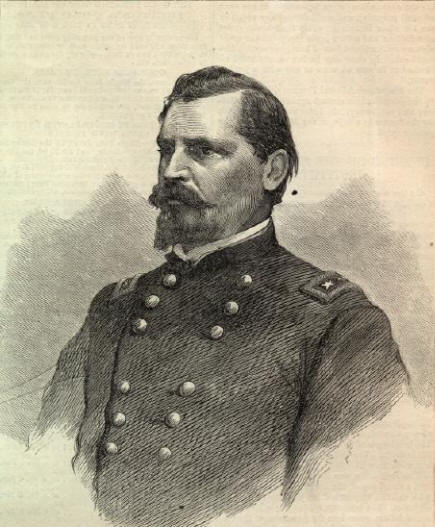 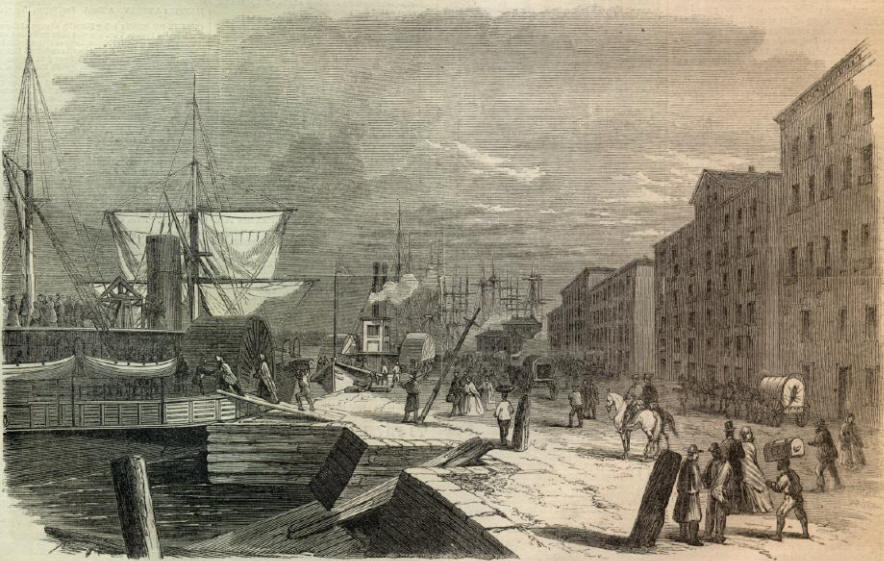 |
||||||||||||||||||||||||
|
|
||
|
|
Site Copyright 2003-2018 Son of the South. For Questions or comments about this collection, contact paul@sonofthesouth.net |
|
|
Are you Scared and Confused? Read My Snake Story, a story of hope and encouragement, to help you face your fears. |
||
